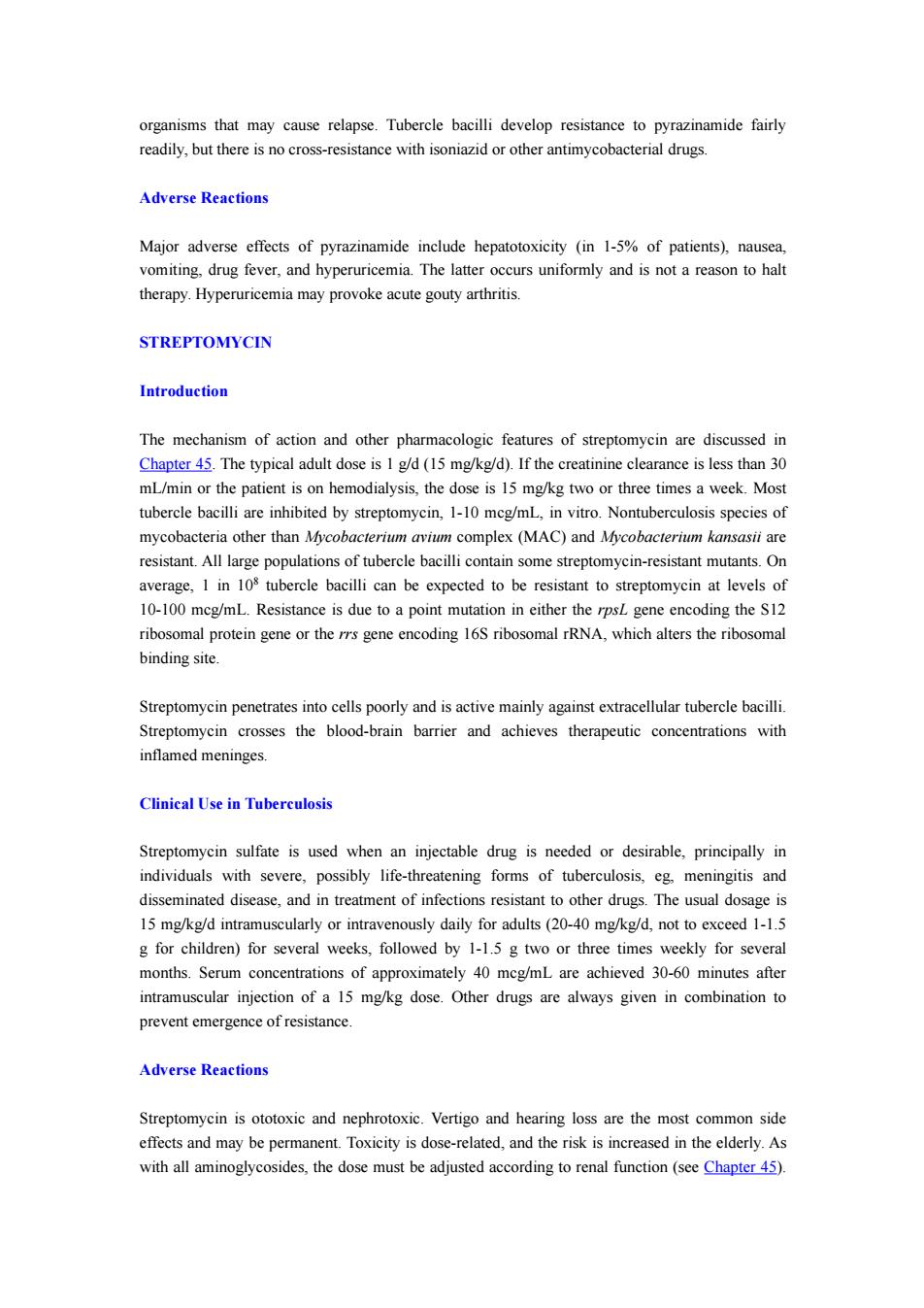正在加载图片...

organisms that may cause relapse.Tubercle bacilli develop resistance to pyrazinamide fairly readily,but there is no cross-resistance with isoniazid or other antimycobacterial drugs. Adverse Reactions Major adverse effects of pyrazinamide include hepatotoxicity (in 1-5%of patients),nausea, vomiting,drug fever,and hyperuricemia.The latter occurs uniformly and is not a reason to halt therapy.Hyperuricemia may provoke acute gouty arthritis. STREPTOMYCIN Introduction The mechanism of action and other pharmacologic features of streptomycin are discussed in Chapter 45.The typical adult dose is 1 g/d(15 mg/kg/d).If the creatinine clearance is less than 30 mL/min or the patient is on hemodialysis,the dose is 15 mg/kg two or three times a week.Most tubercle bacilli are inhibited by streptomycin,1-10 mcg/mL,in vitro.Nontuberculosis species of mycobacteria other than Mycobacterium avium complex (MAC)and Mycobacterium kansasii are resistant.All large populations of tubercle bacilli contain some streptomycin-resistant mutants.On average,I in 108 tubercle bacilli can be expected to be resistant to streptomycin at levels of 10-100 mcg/mL.Resistance is due to a point mutation in either the rpsL gene encoding the S12 ribosomal protein gene or the rrs gene encoding 16S ribosomal rRNA,which alters the ribosomal binding site. Streptomycin penetrates into cells poorly and is active mainly against extracellular tubercle bacilli. Streptomycin crosses the blood-brain barrier and achieves therapeutic concentrations with inflamed meninges. Clinical Use in Tuberculosis Streptomycin sulfate is used when an injectable drug is needed or desirable,principally in individuals with severe,possibly life-threatening forms of tuberculosis,eg,meningitis and disseminated disease,and in treatment of infections resistant to other drugs.The usual dosage is 15 mg/kg/d intramuscularly or intravenously daily for adults(20-40 mg/kg/d,not to exceed 1-1.5 g for children)for several weeks,followed by 1-1.5 g two or three times weekly for several months.Serum concentrations of approximately 40 mcg/mL are achieved 30-60 minutes after intramuscular injection of a 15 mg/kg dose.Other drugs are always given in combination to prevent emergence of resistance Adverse Reactions Streptomycin is ototoxic and nephrotoxic.Vertigo and hearing loss are the most common side effects and may be permanent.Toxicity is dose-related,and the risk is increased in the elderly.As with all aminoglycosides,the dose must be adjusted according to renal function (see Chapter 45).organisms that may cause relapse. Tubercle bacilli develop resistance to pyrazinamide fairly readily, but there is no cross-resistance with isoniazid or other antimycobacterial drugs. Adverse Reactions Major adverse effects of pyrazinamide include hepatotoxicity (in 1-5% of patients), nausea, vomiting, drug fever, and hyperuricemia. The latter occurs uniformly and is not a reason to halt therapy. Hyperuricemia may provoke acute gouty arthritis. STREPTOMYCIN Introduction The mechanism of action and other pharmacologic features of streptomycin are discussed in Chapter 45. The typical adult dose is 1 g/d (15 mg/kg/d). If the creatinine clearance is less than 30 mL/min or the patient is on hemodialysis, the dose is 15 mg/kg two or three times a week. Most tubercle bacilli are inhibited by streptomycin, 1-10 mcg/mL, in vitro. Nontuberculosis species of mycobacteria other than Mycobacterium avium complex (MAC) and Mycobacterium kansasii are resistant. All large populations of tubercle bacilli contain some streptomycin-resistant mutants. On average, 1 in 10 8 tubercle bacilli can be expected to be resistant to streptomycin at levels of 10-100 mcg/mL. Resistance is due to a point mutation in either the rpsL gene encoding the S12 ribosomal protein gene or the rrs gene encoding 16S ribosomal rRNA, which alters the ribosomal binding site. Streptomycin penetrates into cells poorly and is active mainly against extracellular tubercle bacilli. Streptomycin crosses the blood-brain barrier and achieves therapeutic concentrations with inflamed meninges. Clinical Use in Tuberculosis Streptomycin sulfate is used when an injectable drug is needed or desirable, principally in individuals with severe, possibly life-threatening forms of tuberculosis, eg, meningitis and disseminated disease, and in treatment of infections resistant to other drugs. The usual dosage is 15 mg/kg/d intramuscularly or intravenously daily for adults (20-40 mg/kg/d, not to exceed 1-1.5 g for children) for several weeks, followed by 1-1.5 g two or three times weekly for several months. Serum concentrations of approximately 40 mcg/mL are achieved 30-60 minutes after intramuscular injection of a 15 mg/kg dose. Other drugs are always given in combination to prevent emergence of resistance. Adverse Reactions Streptomycin is ototoxic and nephrotoxic. Vertigo and hearing loss are the most common side effects and may be permanent. Toxicity is dose-related, and the risk is increased in the elderly. As with all aminoglycosides, the dose must be adjusted according to renal function (see Chapter 45)